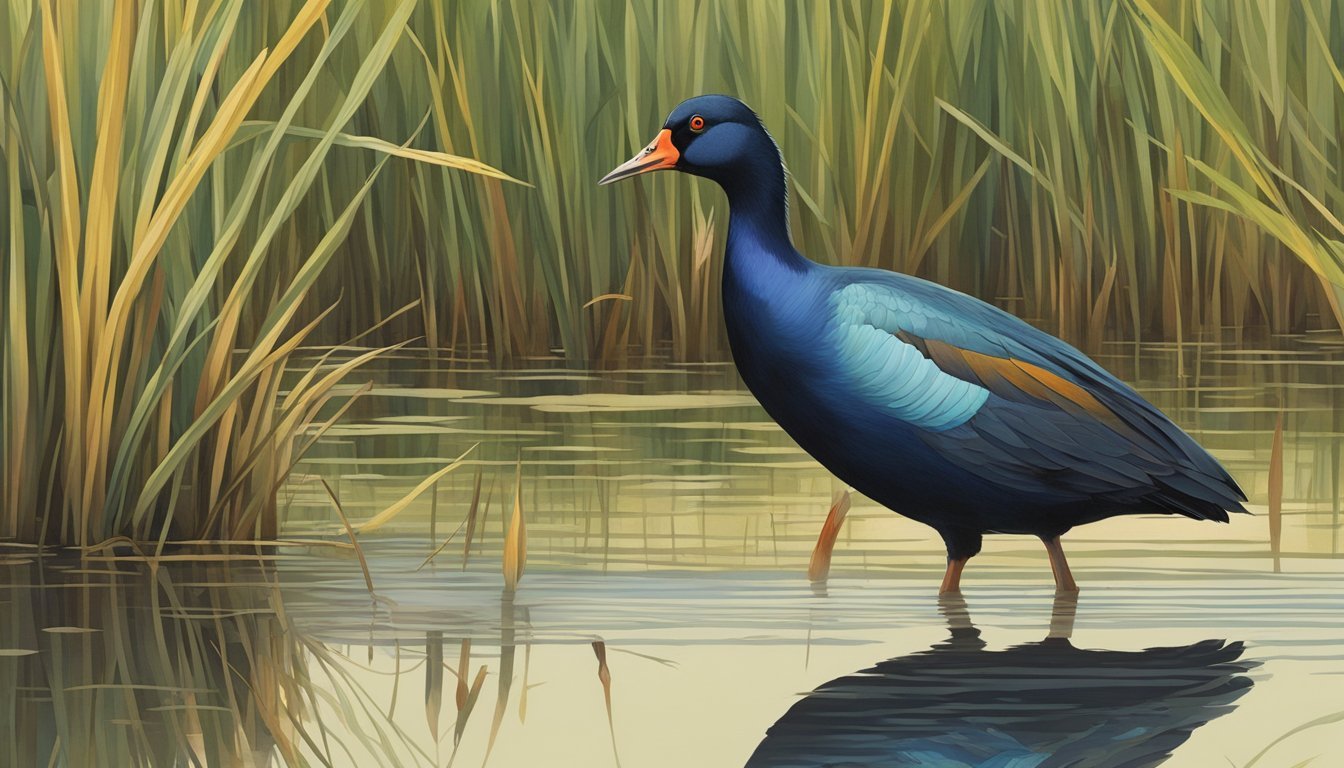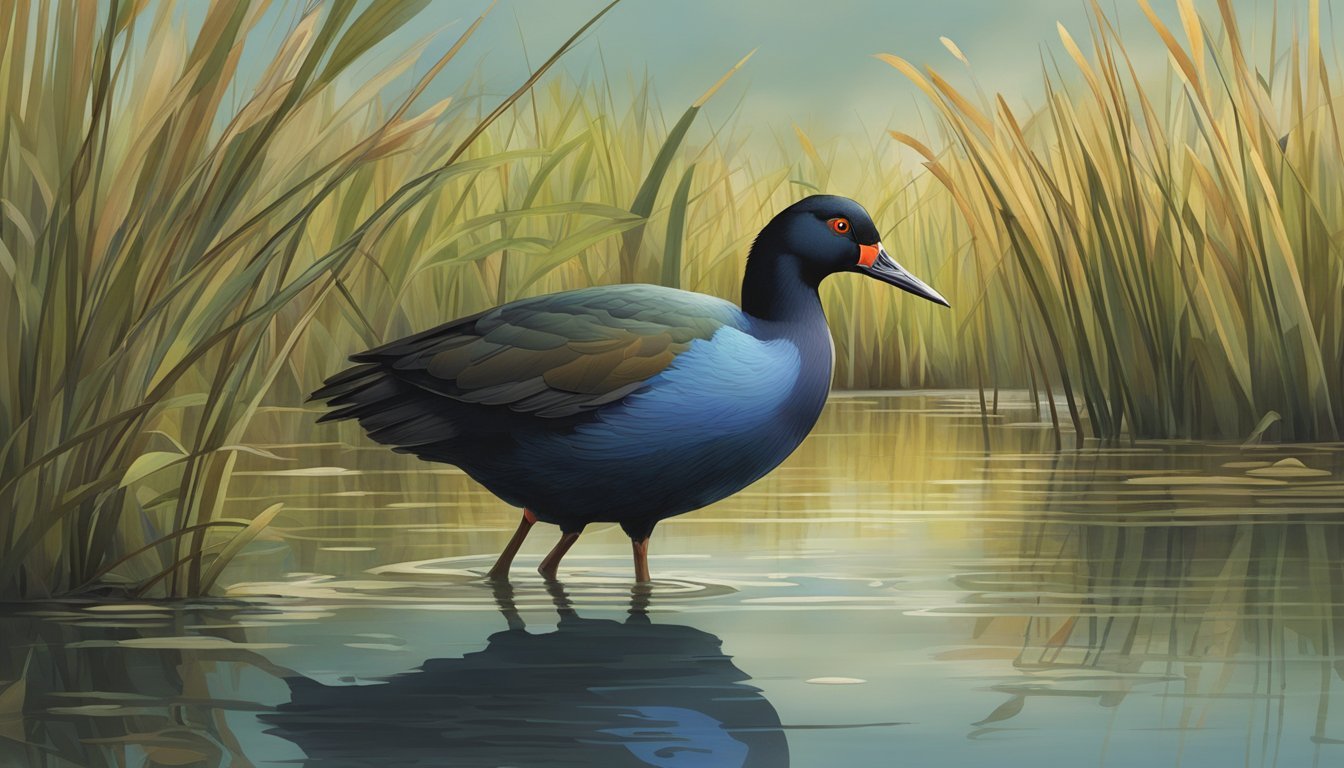Gallinule Hunting Seasons
Regulations and Peak Times Across Regions
This Article is Part of Our Guide on Hunting Seasons for Over 70 Common Game Species
Gallinules, particularly the common gallinule also known as moorhens, are distinctive waterfowl that inhabit wetlands across various states, including Texas and Florida. These birds are characterized by their dark plumage and striking red and yellow bill, making them a unique target for game bird hunters. Their abundance, along with the challenge they provide, has made gallinule hunting an engaging sport for those seeking an experience different from hunting more common game birds.
The hunting seasons for gallinules are regulated by state wildlife agencies, ensuring sustainable populations and fair chase throughout the hunting periods. In Texas, for example, the statewide hunting season for gallinules typically includes separate schedules for the regular season and for falconry. The seasons are carefully structured with specific start and end dates, falling within periods such as early September to late December, with a falconry season sometimes extending into early February.
Regulations for hunting gallinules, including bag limits and hunting hours, are established to balance the needs of hunters with wildlife conservation goals. Hunters are generally allowed to commence their hunt one-half hour before sunrise and must conclude by sunset to adhere to these guidelines. Moreover, all migratory game bird hunters, including those pursuing gallinules, must hold a valid hunting license, which reinforces the responsibility and legality of the practice. These regulations serve to maintain healthy gallinule populations and provide an ethical framework for their pursuit.
Understanding Gallinules
Gallinules are a group of wetland birds that are often confused with their relatives, the coots. This section will help identify the main characteristics of gallinules, focusing on species identification and their unique habitat and behavior.
Species Identification
Gallinules, commonly referred to as moorhens, are a part of the rail family. They can be divided into two well-known species which are often targeted during hunting seasons:
Common Gallinule (Gallinula galeata):
Color: Typically dark gray to black feathers, distinct white flank lines, and white undertail.
Bill: Red frontal shield and yellow-tipped bill.
Purple Gallinule (Porphyrio martinicus):
Color: Bright purple-blue feathers with greenish-black wings and back.
Bill: Yellow bill with a pale blue frontal shield.
Both species exhibit long legs and toes, which facilitate walking on floating vegetation.
Habitats and Behavior
Gallinules are primarily found in:
Freshwater Wetlands: They prefer marshes, ponds, and lakes with ample vegetation.
Wintering Grounds: Some populations migrate to the southern United States, such as Louisiana, Florida, and Texas, to over-winter.
The behavior of gallinules includes:
Swimming: They are adept swimmers, propelling themselves with their lobed toes.
Foraging: They feed on a variety of plant material and small aquatic creatures by pecking and gleaning from the water's surface or the surrounding vegetation.
Understanding these aspects of gallinules is crucial for hunters to ensure proper identification and hunting within the appropriate habitat.
Legal Framework
The regulation of gallinule hunting in the United States is governed by both federal and state laws, which set forth specific hunting seasons, licenses, and bag limits for hunters to adhere to.
Migratory Bird Treaty Act
The Migratory Bird Treaty Act (MBTA) establishes federal oversight for the protection of migratory birds, including gallinules. It specifies that hunting any migratory bird, including gallinules, requires adherence to the federal framework, which determines season dates, bag limits, and hunting hours. For instance, the hunting season dates are confined to a period between September 1 and March 10, as designated by the Migratory Bird Conventions.
State Regulations
States may establish their own regulations within the federal frameworks. Hunters must obtain a valid hunting license and are typically required to possess additional permits or endorsements like the Texas Migratory Game Bird Stamp Endorsement in Texas, or a Federal Duck Stamp when applicable, to legally hunt migratory game birds. State-specific season dates and limits may vary and are often determined annually based on the federal guidelines. For example, in Florida, along with a license, hunters need a no-cost migratory bird permit to hunt gallinules and other migratory game birds.
Hunting Seasons and Limits
When planning for hunting game birds such as Gallinules, hunters must adhere to established daily bag and possession limits, in addition to noting the specific dates that delineate the hunting season. Regulations are designed to ensure sustainable hunting practices.
Daily and Possession Limits
The daily bag limit for Gallinules, which include both Common Gallinules and Purple Gallinules, is set by state wildlife agencies and may vary. Hunters should verify the specific limit for the state they are hunting in. Similarly, possession limits typically allow for a certain number of birds to be in possession which is often a multiple of the daily bag limit.
Daily bag limit: Varies by region.
Possession limit: Generally, multiple of daily bag limit.
Season Timings
Gallinule hunting seasons also vary by state but generally fall within certain dates for both regular and special seasons. For instance, in Texas, the season for King and Clapper Rails, as well as Sora and Virginia Rails, including Gallinules, runs from January 29 to February 12, 2024. It is crucial for hunters to check the exact dates for the state where they will be hunting.
Fall season: Check local regulations.
Spring season: Check local regulations.
Hunting hours are typically restricted from one-half hour before sunrise to sunset to ensure hunter safety and ethical hunting practices. Always consult with local wildlife agencies to confirm the accurate timings and any additional requirements or changes for the season.
Hunting Preparation
Proper hunting preparation for gallinule requires careful selection of equipment and strategic planning. Hunters must equip themselves with the right gear and understand the behaviors of gallinules for a successful hunt.
Equipment Essentials
When preparing for gallinule hunting, one should consider the following critical equipment:
Shotguns: A 12-gauge or 20-gauge shotgun with a smooth bore barrel is commonly used. The choice depends on preference and comfort.
Ammunition: Non-toxic shot is required for hunting waterfowl, including gallinules, to protect the environment and comply with regulations.
HIP Certification: Hunters must have a Harvest Information Program (HIP) certification, indicating their involvement in migratory bird hunting.
Camouflage clothing to blend with marsh environments
Water-resistant boots for wetland conditions
Decoys and calls to attract birds
Binoculars for spotting at a distance
A valid hunting license and any required stamps
Scouting and Strategy
Scouting: Hunters should scout potential hunting areas during the off-season to become familiar with:
Gallinule habitats such as marshes and ponds
Bird patterns and feeding times
Accessibility and any restrictions of the hunting area
Strategy:
Plan to hunt during peak times, often early morning or late evening.
Practice waterfowling techniques like trap or falconry, if applicable
Incorporate stealth and patience into the approach as gallinules can be elusive.
Locations for Hunting Gallinules
Hunting gallinules requires familiarity with their favored habitats and the geographic regions where hunting is permitted. Identifying locations with the right conditions is crucial for a successful hunt.
Prime Gallinule Habitats
Gallinules are attracted to wetland environments, favoring both freshwater and brackish marshes where they can forage and nest. They thrive in areas with ample vegetation, which provides cover and food. Specific prime habitats include:
Freshwater marshes: Lush with vegetation and teeming with insect life, these marshes are ideal for gallinules.
Brackish marshes: The mix of salt and freshwater creates a unique ecosystem where gallinules find abundant resources.
Ponds and lakes: Gallinules frequent the shallow edges where plants like cattails and reeds are prevalent.
Canals and rice fields: These human-made structures often simulate the natural environments gallinules favor, especially when they are flood-controlled and maintain a consistent water level.
Areas with dense plant life, such as cattails, rushes, and other emergent vegetation, are particularly attractive to gallinules as they provide both a food source and protection from predators.
Geographic Hunting Areas
When considering locations for hunting gallinules, hunters should focus on regions known for their wetland habitats. Some of the key areas include:
The Atchafalaya Delta: This region in Louisiana is a prime spot for gallinules with its rich wetland ecosystem.
Pass-a-Loutre Wildlife Management Area: Located at the mouth of the Mississippi River, this area is also well-known for gallinule hunting, offering vast marshy territories.
Pearl River Basin: Stretching across Mississippi and Louisiana, the Pearl River's wetlands are another ideal location for tracking gallinules.
Rice fields: After harvest, these fields in states like Arkansas and Texas are often flooded to attract waterfowl, including gallinules.
These areas provide not only the necessary habitat requirements for gallinules but are also typically managed to support waterfowl populations and hunting activities, with established regulations to ensure sustainable hunting practices.
Associated Species Hunting
When exploring Gallinule hunts, it's important to note the seasons and regulations for associated game species, including various waterfowl and shorebirds, as well as numerous upland and small game species. These hunts often have specific legal frameworks and conservation considerations.
Waterfowl and Shorebirds
Ducks and Geese: The seasons for duck and geese hunting can vary significantly by state and region. Key species include mallards, redheads, canvasbacks, pintail, scaup, and Canada geese. Migratory patterns and breeding areas are crucial in determining the timing of these seasons.
Teal and Wood Ducks: Early season hunts often target teal and wood ducks due to their earlier migration patterns.
Sea Ducks and Divers: Hunters targeting sea ducks such as scoters, long-tailed ducks, eiders, and diving ducks such as redheads may have specialized seasons and zones.
Rails, Snipe, and Woodcock:
Sora and Virginia Rails: These species, alongside moorhens (common gallinules) and purple gallinules, can be hunted in accordance with state regulations during specific seasons.
Snipe and Woodcock: Snipe and woodcock hunts typically follow patterns of migration and are subject to federal frameworks as well as state-level regulations.
Conservation Note: It is critical for hunters to stay informed on population health and legal restrictions to ensure sustainable hunting practices.
Upland and Small Game
Land Fowl and Rabbit:
Turkey and Quail (What wine goes well with quail?): Fall seasons are common for turkey, while quail may be hunted during both fall and winter months, depending on local guidelines.
Youth Hunting Days: Special dates are sometimes set aside for youth hunters to pursue waterfowl, including ducks.
Small Game Mammals:
Rabbit and Squirrel: These small game species have longer seasons, usually spanning from late fall through early spring.
Deer: Larger game such as deer often have distinct seasons, with archery, muzzleloader, and rifle seasons occurring at different times.
Hunting Pressure:
Dove and Crow: Doves and crows are examples of species that may be hunted during specific seasons to manage populations and reduce crop damage.
In summary, hunters must adhere to established seasons for game birds and land game, be they waterfowl, shorebirds, or upland/small game, each regulated to ensure species' sustainability and the integrity of diverse ecosystems.
Conservation and Ethics
In the context of gallinule hunting seasons, both conservation and ethical hunting practices are paramount. They ensure sustainability and a minimal ecological impact, balancing the needs of the environment with the traditions of hunting.
Sustainable Hunting Practices
The Harvest Information Program (HIP) is crucial for monitoring gallinule hunters' activity. Hunters are required to register with HIP, which allows wildlife agencies to gather accurate data on hunting activity and harvest rates. This data informs:
Bag limits: Set to prevent overharvesting, ensuring gallinule populations remain stable.
Season dates: Carefully selected to avoid sensitive breeding periods, protecting vital stages of gallinule lifecycle.
Ecological Impact
Conservation efforts for gallinules focus on habitat preservation and the careful management of population levels. Responsible hunting practices must align with these efforts and consider:
Habitat disturbance: Minimizing disruption to wetlands and other gallinule habitats during hunting season.
Predator-prey dynamics: Maintaining natural balance by avoiding excessive reduction of gallinule populations which can have ripple effects through the ecosystem.
Utilizing ethical hunting principles means that hunters are not only following the law but are also actively participating in the larger conservation efforts essential for maintaining biodiversity.
Additional Resources
The following subsections provide specific resources for hunters and researchers interested in the hunting seasons and regulations for rails and gallinules. They offer comprehensive guides and legal documentation to ensure accurate and lawful hunting practices.
Further Reading
Hunting Guides and Digests:
State wildlife agencies often publish detailed guides and digests available in PDF format which include information on all aspects of hunting various species, including rails and gallinules.
For the South Zone, check the state hunting regulations to identify specific dates and bag limits for gallinule hunting.
Research Articles and Journals:
Academic articles may cover the habits and habitats of rails and gallinules, providing insight into their behavior during different seasons.
Legal Documentation
Hunting Regulations:
Official state websites provide free downloadable PDF documents outlining the legal framework for hunting seasons, bag limits, and special provisions for small game, including rails and gallinules.
Trapping Licenses and Laws:
Documentation regarding trapping regulations can be found alongside hunting guidelines, which are crucial for those considering trapping in their hunting practices.
Conservation and Management Plans:
States with populations of alligator and other species related to gallinules may offer specific management plans addressing the balance between hunting and conservation in various areas such as Area C.
Please refer to the official regulations for each hunting season before planning your hunt to ensure compliance with all current laws and conservation efforts.






